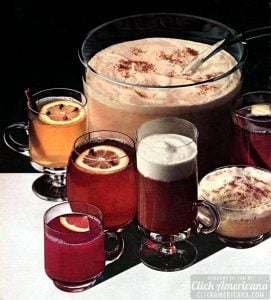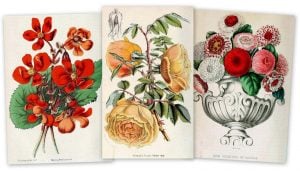Try this easy but but elegant suncatcher DIY you can make in your oven
We have updated this suncatcher DIY project slightly, mainly because transparent plastic pellets aren’t so easy to come by nowadays. However, translucent plastic beads like the pony beads that you can get today have many of the same qualities, so you might want to consider using them instead. (You can get more tips on the process from the Adventure Science Center in Nashville.)
Of course, if you use bigger beads, the finished pieces will probably look a bit different from the vintage pictures on this page, but we hope they will inspire your creativity!
There’s no doubt that you can make some stunning and colorful decorations even without tripping back in time.

Melted bead suncatcher DIY: Crafty plastic decorations you can make in your oven (1964)
by Margo Garrity – Better Homes & Gardens, November 1964
Be creative! “Cook” up a houseful of ornaments from brilliant plastic pellets. You can form your own molds of heavy aluminum foil or use flat cookie sheets, muffin tins, or salad [gelatin] molds.
Colored pellets are now available in sparkling colors. Embed them with colored foils, glass nuggets, cabochons, marbles, shells, etc. for countless interesting designs.

Hang them in the window, fashion them into mobiles — these eye-catchers are impossible to buy ready-made!
Heated plastic is not a liquid, but resembles a very thick, sticky, rubbery gelatin. A good loud kitchen timer is a disappointment-saver. Note: Plastic is flammable. Do not expose to direct heat, such as under a broiler.

After pellets have been baked at 375 (F) for twenty to thirty minutes, allow them to cool. Heat an ice pick over the burner and pierce a hole. [You might want to carefully drill a hole instead.] Insert nylon fishing line to hang ornament.

Snowflake suncatcher DIY with ribbon
Cut snowflakes out of ribbon. Place a small number of clear pellets onto a flat, smooth pan or cookie sheet; lay ribbon on pellets. Cover with more clear crystals. Shape into a cross by hand or with a spatula before baking.

Sandwich ribbon between crystals, bake at 375 (F) for twenty minutes on a bowl and twist extensions the shape of a windmill.

Red and white melted bead medallion suncatcher DIY
Most medallions are made by prefabricating smaller pieces in muffin tins. Then they are fused into an overall larger pattern.
To start: Cover bottom of tins completely. If thicker ornaments are desired, use more pellets.

Above, red pellets are fused to clear ones. Arrange both red and clear circles on a flat pan into an over-all pattern. With more pellets, fill in around circles taken from muffin tins.
MORE: Remember making salt dough ornaments for Christmas? Here’s how to do it again
A second baking fuses them together into the desired pattern. Colored crystals can be sprinkled at random onto clear ones, then baked for five to ten minutes to add texture.


Twenty minutes is the average baking time at 375 (F). If the resin is baked too long, it develops large bubbles. To save cleaning, cover oven floor with foil.
For a variation, make a fruit or cracker bowl. Place the flat object over a heavy glass or metal container to shape into a bowl. For ease in removing from oven, place bowl and ornament on a flat tin.
Bake at 375 (F). Sometimes it takes only three or four minutes to reach the pliable stage. Work with knife to get desired shape. If plastic becomes stiff, reheat; if too sticky, allow to cool.

Double-layer melted bead suncatcher DIY
When using two colors, form shape on a flat cookie sheet. Here, each shape was made by placing about 1/2 crystals on pan, then working the edge of pan as though finger painting. The centers were left free.
Fuse the top to the bottom piece when the latter is very hot and sticky. It can be fused together in a second or third baking.


More plastic suncatcher crafts from 1962
The abstract owl suncatcher was made in parts, formed separately in foil molds and then fused. Wire feet were heated and then inserted. The plastic people and animals were made the same way.


Below, see a variety of textures, shapes and colors you can create by carefully melting plastic beads or pellets.

Multi-panel hanging suncatcher DIY room divider
This decorative suncatcher room divider was made using two different sizes of pans as molds. The silhouettes were cut from foil and embedded in green pellets. Both sides had additional pellets fused on lightly for texture. Screw eyes were heated and inserted to hold the chain.

MORE: Vintage Shrinky Dinks: How these crafty toys were invented & how they work



















